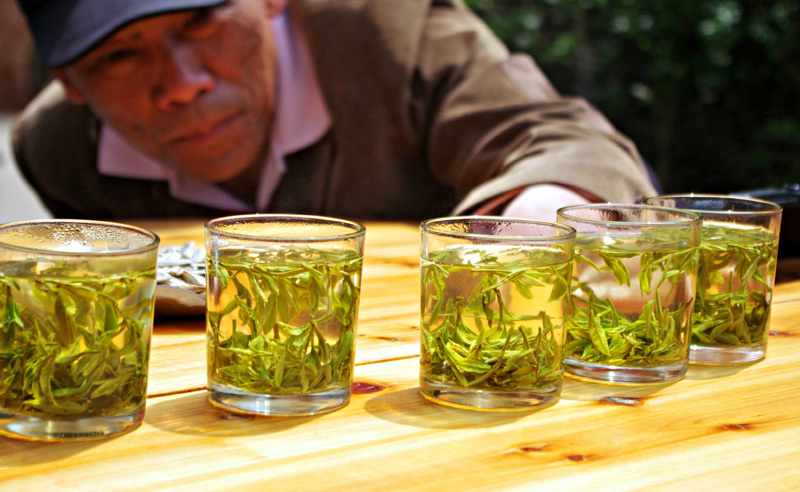Category Archives: Tai Chi Theory
Tea and Tai Chi: a way of being-in-the-world
“The journey of a thousand miles begins with a single step (…or sip)” Lao Tzu.
The relationship of Tai Chi to Tea is, like anything to do with Chinese traditional culture a long and complex story. However we can take a first step in understanding this story with a very simple idea; Cǎi (採, cǎi) pronounced Tsai. One of the Eight Basic Methods of Chen Style Taijiquan[1], Cǎi means to pluck, taking its name from the short sharp twist used to pick the tips of the tea bush (採茶, cǎi chá). The move follows the flow of approaching force and without interruption diverts it into emptiness.
To give another example, Wave Hands Like Clouds (云手 Yún shǒu) is another very famous Tai Chi movement. To move hands like clouds is to move with a natural soft flowing movement but with intention. This doing without doing is one of the attitudes of thinking and doing that is inherent in Daoism. Tea drinking similarly embodies Daoist ideas in the way in which sharing tea is an opportunity to be mindful and truly present. They are interlinked through their spirit, they both seek to refresh one’s mind and body. So it seems that mindfulness and stillness can be practiced equally through the ritual of making and imbibing tea, as it can through the practice of Tai Chi forms. So from the start we can see an example of how Tai Chi, Tea and the principles of Daoism are all intricately interwoven.
Practising Tai Chi form reveals for us many aspects of Daoist spiritual culture and drinking tea offers us yet another way to integrate this feeling of being-in-the-world into our daily lives and way of looking at the world around us. Being-in-the-world is to be in the middle of the world, amongst things, immersed in the now. Kakuzo Okakura writes in the classic Book of Tea[2] (1906), “Chinese historians have always spoken of Daoism as the ‘art of being-in-the-world,’ for it deals with the present–ourselves. It is in us that God meets with Nature, and yesterday parts from to-morrow.”
Out of stillness we come into presence, being part of the world in harmony and balance with nature. A very Daoist concept, the ‘tea-mind‘, that is to say, “a way of being-in-the-world, a way of living a life of grace and gratitude, of being able to see the sacred in the seemingly mundane”. This is the heart of Daoism, and we are told, the way of tea (茶道chá dào). It is also the way of Tai Chi.
Drinking tea has been a Chinese custom for thousands of years, with the earliest records dating back to the 10th-century BC. Chinese philosopher Laozi described tea as the “froth of the liquid jade“, and called it an indispensable ingredient in the elixir of life by which he means it is an important contribution to our longevity and health. In his book Cha Dao: The Way of Tea, Tea as a Way of Life, Solala Towler writes, “Daoists follow nature… and so Daoists like tea because it comes from nature. Tea is the flavour of the Dao”.
Indeed the health benefits of Tai Chi and tea are complimentary as many scientific studies have shown. Dr. Greenwood[3], an expert on the relationship between diet, nutrition and brain health, tells us that “the compounds in tea appear to impact virtually every cell in the body in a positive health outcome, which is why the consensus emerging from this symposium is that drinking at least a cup of clear green, black, white or oolong tea a day can contribute significantly to the promotion of public health”. So drinking tea has a whole body benefit just like Tai Chi.
Meanwhile, researchers at Texas Tech University Health Sciences Centre have established that a combination of Tai Chi exercise and green tea can contribute to improved bone health and muscle strength. So in combination Tai Chi and tea means healthy bones, improved balance, clarity of thought, and a boost to the immune system.
Aside from individual benefits Tai Chi is often performed with others and and brings with it benefits of social inclusion. Being part of group, meeting and practicing with others it’s essence is social harmonising the individual in the social. Tea too, brings people together and reflects the individuals relationships within the world.
Tea and Tai Chi is being-in-the-world, being part of the world, being in harmony with the world, being in nature.
Author :
Tai Chi improves memory
Tai Chi makes your brain bigger and can improve memory and thinking – possibly delaying the onset of Alzheimer’s disease, claim scientists. – The Telegraph –
A new study has revealed how elderly people practising Tai Chi – an ancient Chinese form of slow, meditative exercise – just three times a week can boost brain volume and improve memory and thinking.
As the exercise increases mental activity, scientists believe it may be possible to delay the onset of incurable Alzheimer’s in pensioners.
Dementia and the gradual cognitive deterioration that precedes it is associated with increasing shrinkage of the brain, as nerve cells and their connections are gradually lost.
Previous research has shown Tai Chi can help relieve stress, improve balance in the elderly and stave of high blood pressure – helping those who suffer from heart disease.
Although scientists know brain volume can be increased in people who participate in aerobic exercise, this is the first study to show a less physical form of working out, like Tai Chi, can have the same results.
Researchers conducted an eight month controlled trial on Chinese seniors, comparing those who practiced Tai Chi three times a week to a group with no intervention.
Participants also had lively discussions three times a week over the same time period, with results showing a similar increase in brain volume and improvements on memory and thinking as those exercising.
Findings also revealed the group who did not participate in Tai Chi showed brain shrinkage over the eight months – consistent with what generally has been observed for elderly people in their 60s and 70s.
The research suggests forms of exercise like Tai Chi, that include an important mental health exercise component, are associated with increased production of brain growth factors like aerobic exercise.
Dr James Mortimer, of the University of South Florida, said: “If this is shown, then it would provide strong support to the concept of ‘use it or lose it’ and encourage seniors to stay actively involved both intellectually and physically.
“The ability to reverse this trend with physical exercise and increased mental activity implies that it may be possible to delay the onset of dementia in older persons through interventions that have many physical and mental health benefits.
“Epidemiologic studies have shown repeatedly that individuals who engage in more physical exercise or are more socially active have a lower risk of Alzheimer’s disease.
“The current findings suggest that this may be a result of growth and preservation of critical regions of the brain affected by this illness.”
The study, helped by Fudan University, China, was published in the Journal of Alzheimer’s Disease.
Tai Chi Theory
Tai Chi Theory
TAI CHI
Tai Chi movements are slow soft and graceful with smooth and even transitions between them, The meditative nature of the exercises is calming and relaxing.
Tai Chi Chuan or (taiji quan) exercise helps blood to move around inside the body. This is very important blood takes food to all parts of our bodies ,the brains in our heads also need blood. If we keep our bodies healthy and do exercises, we can think better.
TAI CHI & HEALTH
When practising Tai Chi, the practitioners consciousness, breathing and actions are all closely connected. The transfer and focus of the practitioners energy corresponds to the network of maridians joining the acupuncture points used in traditional Chinese medicine. Tai Chi exercises stimulate blood circulation and the inner organs, as well as improving strength and muscle control.
Tai Chi exercises help to improve health, co-ordination and posture and will promote general fitness and weight loss. Tai Chi stimulates the body and calms the mind, resulting in a balanced outlook and an overall improved sense of well being.
TAI CHI PUSH HANDS
Push-hands is a practice method of traditional Tai Chi martial arts. Two students with their arms in contact practice twining and sticking actions to develop the sense of touch, awareness and balance within the body.
This is the training method where Tai Chi movements connect with martial arts applications, and develops the understanding of how small forces can defeat strong physical power.









